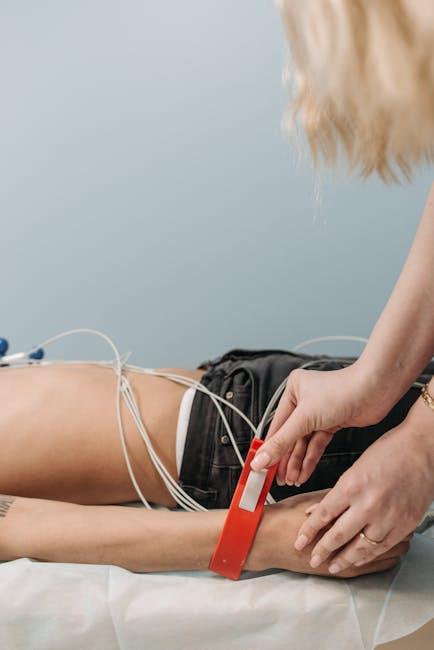In today’s fast-evolving digital landscape, mobile phones have journeyed far beyond their original purpose of simple communication. Once seen as mere devices for calls and texts, they are now emerging as powerful health diagnostic tools, transforming the way we monitor and manage our well-being. With the convergence of advanced sensors, artificial intelligence, and connectivity, the smartphone in your pocket is increasingly becoming a personal health companion-capable of detecting symptoms, analyzing vital signs, and even predicting potential medical conditions. This article explores the innovative realm where technology meets healthcare, uncovering how mobile phones are reshaping diagnostics and empowering users to take charge of their health like never before.
The Evolution of Mobile Phones in Health Diagnostics

From bulky devices tethered to hospitals to sleek gadgets in the palms of millions, mobile phones have revolutionized health diagnostics. Initially limited to simple step counters and calorie trackers, their capacity has expanded dramatically with the integration of advanced sensors and AI algorithms. Today, smartphones can measure heart rates, analyze blood oxygen levels, and even detect irregular heartbeats through apps paired with wearable devices. This transformation has brought healthcare closer to the user, empowering individuals to monitor their well-being continuously without frequent hospital visits.
Several features have paved the way for this evolution, including:
- Multi-sensor arrays: Cameras, accelerometers, and infrared sensors collaboratively gather comprehensive health data.
- Cloud connectivity: Enables real-time data upload and remote diagnostics by medical professionals.
- Machine learning models: Provide predictive analytics enhancing early detection of conditions like diabetes and arrhythmias.
- Enhanced user interfaces: Simplify interaction for all age groups, increasing adherence to health monitoring routines.
| Feature | Diagnostic Use | Benefit |
|---|---|---|
| Camera + AI | Skin lesion analysis | Early skin cancer detection |
| Pulse Oximeter | Blood oxygen level check | Monitoring respiratory health |
| Accelerometer | Fall detection | Immediate emergency alerts |
Harnessing Sensors and Apps for Real-Time Health Monitoring

Modern mobile phones are equipped with a variety of sensors such as accelerometers, gyroscopes, heart rate monitors, and even SpO2 sensors, transforming them into compact health diagnostic tools. These embedded technologies capture real-time physiological and environmental data, allowing users to track vital signs continuously without the need for bulky medical devices. By integrating with intuitive applications, phones can monitor parameters like heart rate variability, sleep patterns, and oxygen saturation, offering personalized insights that were once confined to clinical settings.
Leveraging these capabilities, mobile health apps provide immediate feedback and alerts, empowering users to take proactive steps toward wellbeing. Essential features include:
- Real-time data visualization for instant understanding
- Customized notifications based on individual health thresholds
- Seamless syncing with cloud services for longitudinal tracking
- Integration with wearable devices to supplement data accuracy
| Sensor | Function | Common Use |
|---|---|---|
| Accelerometer | Detects movement and orientation | Step counting, fall detection |
| Heart Rate Monitor | Measures pulse rate | Cardiac health, workout tracking |
| SpO2 Sensor | Assesses blood oxygen levels | Respiratory monitoring |
Challenges and Ethical Considerations in Mobile Health Diagnostics

The integration of mobile phones into health diagnostics introduces an array of technical and ethical challenges that must be navigated with care. One primary concern is the accuracy and reliability of the diagnostic data collected via mobile apps and sensors. Unlike traditional medical devices that undergo rigorous testing and certification, many mobile health tools still lack standardized validation, raising questions about the risk of misdiagnosis. Furthermore, technological limitations such as inconsistent device hardware and varying environmental conditions can compromise the quality of diagnostic results. These hurdles highlight the critical need for robust quality control mechanisms and ongoing clinical validation to ensure trustworthy health assessments.
Ethical considerations are equally pressing as the widespread use of mobile diagnostic tools intersects with issues of privacy, consent, and data security. Patients’ personal health information is highly sensitive, and the potential for data breaches or unauthorized sharing poses significant risks. Users must be fully informed about how their data will be used, stored, and protected, which demands transparent and clear communication from app developers and healthcare providers. Key concerns include:
- Informed Consent: Ensuring users understand the scope and limits of mobile diagnostics.
- Data Ownership: Clarifying who owns and controls the diagnostic data collected.
- Bias and Accessibility: Preventing disparities caused by uneven access to mobile technology or biased algorithms.
- Regulatory Compliance: Aligning mobile health tools with evolving legal frameworks.
| Challenge | Potential Impact | Mitigation Strategy |
|---|---|---|
| Data Privacy | Exposure of sensitive health info | End-to-end encryption & strict policies |
| Diagnostic Accuracy | Misdiagnosis or delayed treatment | Clinical validation and updates |
| User Consent | Uninformed data use | Clear consent forms, ongoing communication |
Future Directions and Practical Recommendations for Integration

Advancing the integration of mobile phones as health diagnostic tools depends heavily on fostering collaborative ecosystems. This means bridging the gap between technology developers, healthcare providers, and regulatory authorities to ensure seamless adoption and trustworthiness. A key component will be the development of universally accepted standards for data accuracy, privacy, and interoperability. Additionally, investing in user-friendly interfaces tailored to diverse populations can expand accessibility, making diagnostic tools not only smart but genuinely inclusive. Embracing AI-driven algorithms that learn and adapt in real-time will further enhance diagnostic precision while addressing evolving health challenges.
- Strengthen cross-sector partnerships to accelerate innovation
- Focus on ethical frameworks to safeguard patient data
- Promote continuous user education to increase engagement
- Encourage modular hardware designs for scalable upgrades
To support these technical and strategic goals, healthcare systems can adopt a phased implementation plan balancing innovation with reliability. Below is a simplified roadmap illustrating key milestones and stakeholder roles:
| Phase | Focus | Key Stakeholders | Outcome |
|---|---|---|---|
| Exploration | Prototype development and initial trials | Tech innovators, researchers | Validated proof of concept |
| Validation | Clinical testing and regulatory review | Medical institutions, regulators | Certification and safety approval |
| Adoption | Integration into healthcare workflows | Hospitals, insurance providers | Widespread implementation and monitoring |
The Conclusion
As mobile phones continue to evolve beyond communication devices into sophisticated health diagnostic tools, they hold the promise of transforming how we monitor and manage our well-being. Bridging the gap between technology and healthcare, these pocket-sized innovations offer convenience, accessibility, and real-time insights that could redefine preventive medicine. While challenges remain-ranging from accuracy and privacy to equitable access-the growing integration of mobile diagnostics signals a future where health empowerment is literally at our fingertips. In this dynamic landscape, the true potential of mobile phones as personal health allies is only just beginning to unfold.













